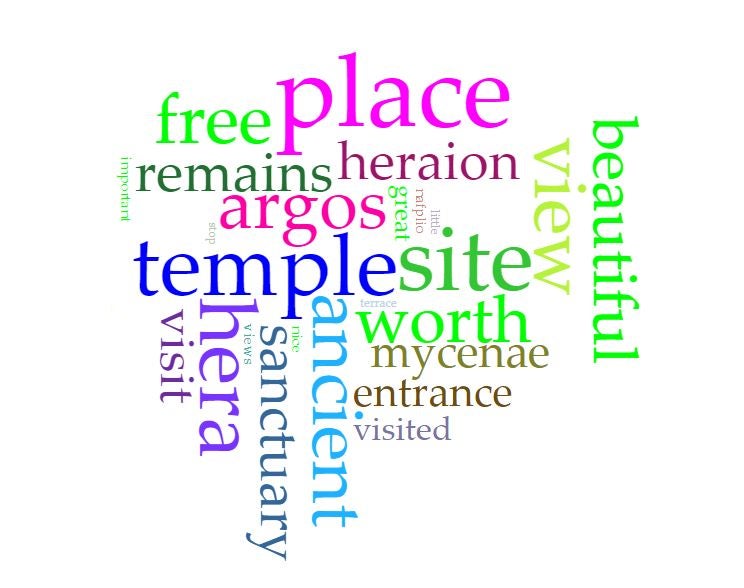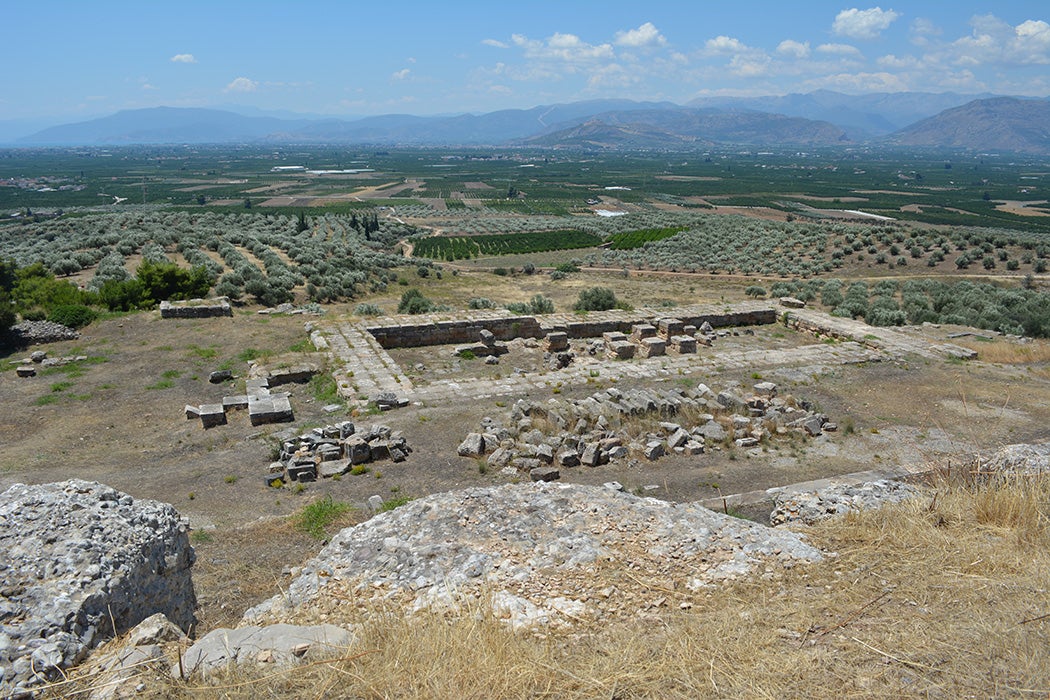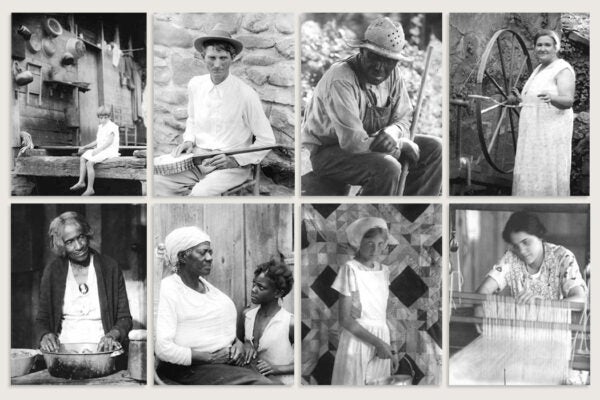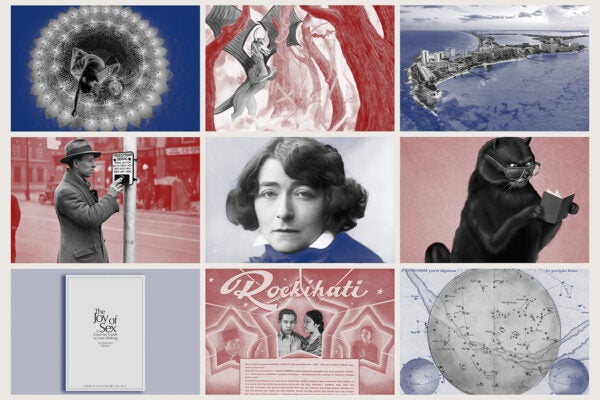When we travel through the landscape, certain features stick out. These are our landmarks: sights and places that evoke a sense of familiarity. Landmarks tell us where we are and where to go next; they help ground us in the world. People create landmarks; people change them too. As cultures, beliefs, and practices shift, existing landmarks might be forgotten, or transformed, alongside other landmarks continuing to evolve. Greece’s Argive Heraion sanctuary is a compelling example of how a place retains its value as a landmark over time and through change, but in different ways. It teaches us: a landmark isn’t a singular entity, but many. Using text analysis tools such as JSTOR’s Constellate helps archaeologists see how the meanings and interpretations of heritage sites have changed over time.
The Argolid is a modern and ancient sociocultural zone in the northeastern Greek Peloponnese, located south of Corinth. It’s fairly mountainous, with a central flat plain known as the Argive Plain. The plain’s northern boundary is delineated by mountains, including one called Mount Akraia. In the Bronze Age, a group of Mycenaeans lived on its southern face. This settlement was called Prosymna, and there was a cemetery around its borders. The dead were buried in graves dug directly into the hill, except for one monumental tholos tomb. Greece began experiencing widespread sociopolitical changes in the eleventh century BCE, and Mycenaeans abandoned Prosymna and the cemetery.
There’s no archaeological evidence at Prosymna for nearly a century after the abandonment. By the ninth century BCE, however, we can tell that Greeks became deeply interested in the Argolid’s history. The Greeks established sanctuaries at Mycenaean citadels and cemeteries across the Argolid, including at Prosymna. At Prosymna, they buried votive objects throughout the old settlement. Near the monumental tholos, they built a platform and used it to worship in the open-air.
The sanctuary there continued to grow. In the eighth century BCE, worshipers began burying votives in the Mycenaean graves. They replaced the platform with something bigger, further uphill. The new terrace was massive and right in the middle of Prosymna, on a sort of natural shelf that overlooked the plain below. Archaeologists agree: the Greeks purposely made this terrace look old. They used “cyclopean style” stones, mimicking those Mycenaeans had used to build their citadels.
The Greeks kept building. In the seventh century BCE, they erected a stone temple on top of the terrace and dedicated it to Hera. Then a priestess accidentally burned down the temple in the fifth century BCE, and worshipers had a serious decision to make. Should they rebuild, or should they respectfully abandon the sanctuary, and go worship elsewhere? Neither option was perfect. As Classicist Christopher Pfaff indicates, building atop the ruined temple’s foundations was controversial. In the end, the Greeks struck a compromise: memorialize the ruined temple and build a new one slightly downhill.
Something about this place resonated with worshipers; Romans even used the sanctuary when they gained control of the Argolid. The archaeological record gives us many clues as to why. The Argive Heraion was built on an already-ancient landmark, and worshipers wanted to physically engage with it. Ancient authors don’t mention the Argive Heraion until the fifth century BCE, when Herodotus included it in his infamous Histories, and even after that, the scope of written evidence is still somewhat limited. The authors are well-to-do Greek and Roman men, and some of them probably never visited the sanctuary in person.
Take a look at the Word Cloud below; it was made using Voyant. It visualizes every ancient Greek and Roman passage mentioning the Argive Heraion, between the fifth century BCE and the third century CE. You can interact with the full dataset in Voyant here.

When ancient authors did comment, they saw three intertwined sanctuaries: the Argive Heraion was a religious, historical, and political landmark. They framed the sanctuary’s religious functions with respect to other historical landmarks: “Prosymna,” as well as “Mycenae,” a nearby Mycenaean citadel. It’s worth noting that Mycenae was also transformed into a Hera sanctuary, just as it was at Prosymna.
When the Argive Heraion was founded in the ninth century BCE, it was a “regional” sanctuary—many towns and villages used it, and there was no single community responsible for its upkeep. Yet, ancient authors, writing between the fifth century BCE and the third century CE, frequently connected “Argive Heraion” and “Argos.” Many of them knew Argos as a powerful city-state that had assumed control of the sanctuary (as well as the rest of the Argolid). That’s why “Cleobis” and “oxen” appear in the word cloud. Authors were recounting the infamous myth about Cleobis and Biton, two brothers who dragged their mother from Argos all the way to the Argive Heraion. The whole story is propaganda, explain archaeologists Joseph Maran and Alcestis Papadimitriou. Argos perpetuated a fictional but long-standing connection to the Argive Heraion: an already ancient, sacred, and recently politicized landmark.
That Word Cloud stops at the third century CE, though people have continued to use and think about the sanctuary. For historians and archaeologists working in Greece, the Argive Heraion is a touchstone, an archaeological landmark. Check out this Word Cloud below, made using JSTOR’s Constellate lab. I built the visualization using scholarly articles that mentioned “Argive Heraion” (and variants) in the title, published between 1900 and 2023.

Like the ancient authors, modern scholars are equally vested in religious-themed words such as “temple,” “sanctuary,” and “Hera.” Context matters, though. Modern historians and archaeologists don’t necessarily mark the Argive Heraion on their religious landscapes. Rather, they think about the space in terms of evidence (e.g., “roof,” “column,” “archaic [style],” “capital,” “fragments,” and so on) and answer questions about its religious function in the past. The Argive Heraion has transformed; it’s now an archaeological landmark.

But Archaeologists and historians aren’t the only ones thinking about the sanctuary. The Argive Heraion is open to visitors, and tourists write about their experiences online. Here’s one last Word Cloud, using English-language reviews published between 2002 and 2023 on Trip Advisor and Google reviews. You can interact with the full dataset in Voyant here.

Like modern historians and archaeologists, tourists regard the Argive Heraion as an archaeological landmark—they just frame it differently. Tourists speak about their personal sensory experiences—smells, sights, touches—and we see the emotional responses that result. We learn that the Argive Heraion has undeniably gorgeous views, but Mycenae (just down the road) boasts more impressive archaeological remains. Tourists are understandably concerned about amenities and accessibility: hours of operation, entrance fees, directions to the site, and the lack of descriptive signage. They’re evaluating the visitor experience, helping others decide if the Argive Heraion is worth it.
For archaeologists and historians, landmarks are keys for unlocking the past. They tell us where people were pausing, and they provide context for what mattered for a person (or people) at that location, at that specific period of time. Those lessons stretch to the present day: people can regard and value the same place in different ways. The Argive Heraion, the Hagia Sophia, the Holy Mount—all of these enduring religious landmarks become emblazoned in our memories for different reasons. A landmark is versioned and layered, and it impacts us all differently.
Editor’s Note: This story was amended to correct a broken link leading to Constellate.
Support JSTOR Daily! Join our membership program on Patreon today.







